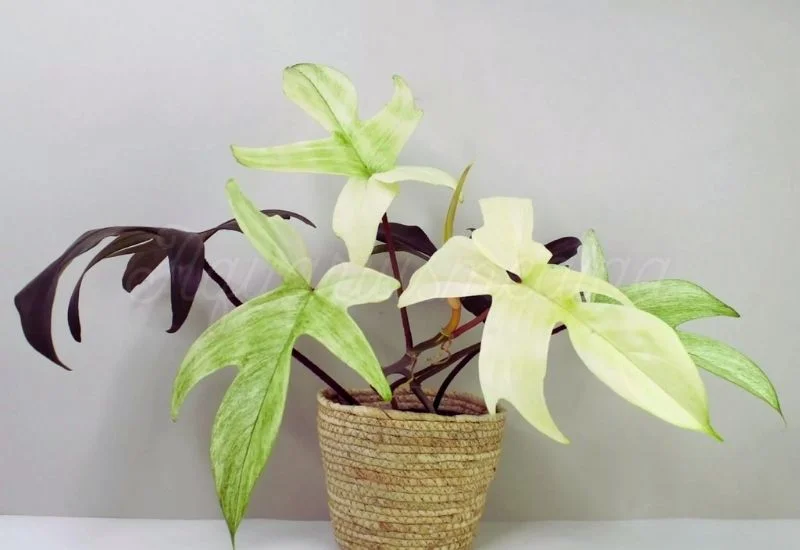In this blog post, you’re going to learn how to easily propagate and care for Philodendron Florida Ghost.
This is a comprehensive guide covering reliable information about different aspects of this variety.
In this post, I’ll cover:
- Interesting Facts
- Propagation
- Repotting
- Care
And
- Solutions to Common Problems
So, if you are looking to propagate and care for Philodendron Florida Ghost, this guide is for you.
Fun Facts
| Common Name | Philodendron Florida Ghost, Florida Ghost |
| Botanical Name | Philodendron squamiferum |
| Family | Araceae |
| Plant Type | Perennial |
| Fruit | Poisonous berry-like (rarely) |
| Mature Size | 2-5 ft. tall |
| Sun Exposure | Bright and indirect light |
| Soil Type | Well draining soil |
| Soil pH | Acidic |
| Native Area | Tropical regions of South America |
| Toxic | Toxic to humans and pets |
| Growth | Climbing nature |
Philodendron florida-ghost is one of the favorite plants grown and liked by plant lovers due to its characteristics. This plant has one of the most recognizable features, which is the ghost-like shape of its leaves. First, the foliage is relatively soft, close to being white when the plant is juvenile, but turns green when it reaches ripeness.
Its feature is the gradual changing of the shades, making the plant itself a brilliant ornament in any assortment. The Philodendron Florida Ghost is somewhat related to other Philodendron types; however, its silver and soft-skinned marbled leaves give it a ghost-like appearance.
In terms of growth period, the Philodendron Florida Ghost is classified as a slow-growing plant compared to many other plants in the Philodendron category. It also contains conditions characteristic of its natural tropical environment, The warm temperatures and high humidity enhance the plant’s growth.
Like most Philodendron species, the flower structure of Philodendron Florida Ghost is not extensive. It has small, inconspicuous, or even unimportant flowers. This flower belongs to the Araceae family and includes a spathe and a spadix.
Flowering and Fruits
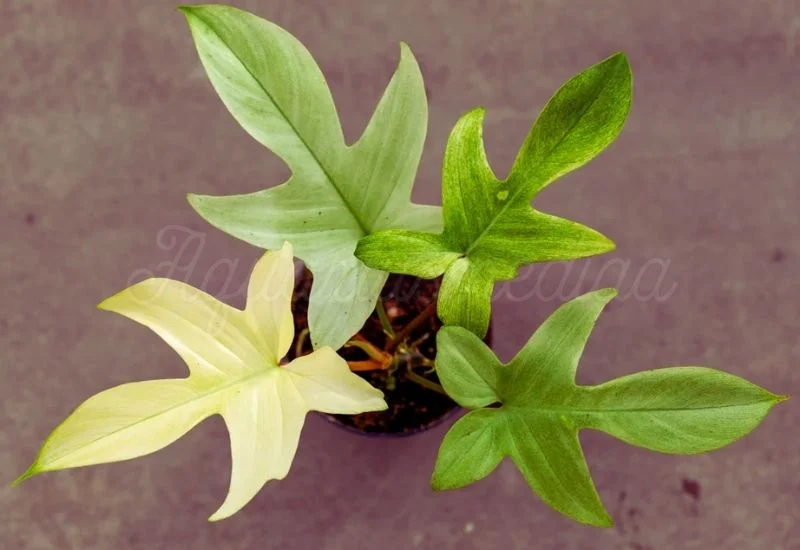
Gardeners and lovers of this plant don’t value flowering traits; they concentrate more on the appearance of the plant’s leaves. The structure’s minimalistic and subdued floral design directs attention to the plant.
The plant’s fruit structure is also less apparent than other aspects. When the plant does bear fruit, the spadix is evident and ripens to a small, inconspicuous, fleshy berry-like structure. These fruits are not impressive in terms of ornamental use.
Benefits
The Philodendron Florida Ghost is among the most sought-after plants, and there are numerous reasons why this is the case; most key areas are associated with its looks, simplicity of being followed, and benefits.
Here’s a detailed note on the advantages of incorporating this unique plant into your living space:
Aesthetic Appeal
The Philodendron Florida Ghost is known for its striking and appealing leaves. Their stem bears from a pale, near-invisible white to turn into a rich black-green, creating a stunning contrast. The remarkable form and the gradual change of shades in the veins of these plants’ leaves, creates a large and varied plant that becomes the center of attention in homes, offices, Cafes, restaurants, and other establishments.
Low Maintenance
This variety of Philodendron does not require much attention and can be considered ideal for both beginners and experienced gardeners. It prefers normal interior conditions. Also, it grows best in moderate to bright indirect light; it needs to be watered rarely. It should be noted that it hardly requires much care and is easy to groom in any collection.
Air Purification
Like most members of the Philodendron genus, it is also an air-purifying plant. It can remove over ninety percent of the airborne particles and also prevent formaldehyde, benzene, and xylene from diffusing through the air.
Indoor plants such as the Philodendron Florida Ghost can greatly improve and create healthier living spaces.
Versatility in Decor
Due to its exotic characteristics and ability to change colors, it harmoniously fits into multiple interior design styles. It can be grown in decorative pots, hanging baskets, or as a climber.
As such, it is a Desirable tool that may increase the appeal of various areas.
Stress Reduction
As per research, caring for and growing plants is beneficial to someone’s health because it lowers stress levels and fosters improved mental health.
The process of taking care of living plants can be a satisfying and soothing activity. It has been proved that the presence of greenery results in relaxation, sharpens the brain, and is pleasing to the eyes.
Uses
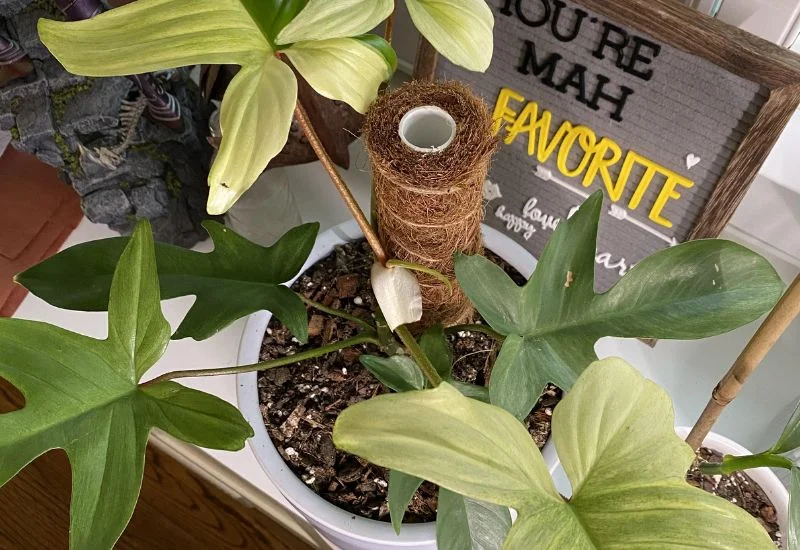
Let’s explore the few benefits of the philodendron Florida ghost;
Healthier Environment
Filtration removes toxic components from the air, thereby creating a healthy environment.
Productivity Booster
The presence of indoor plants like Florida ghost philodendron helps to increase the focus on work and efficiency.
Indoor Decoration
Due to its aesthetic appeal, it plays an important role in the indoor beauty with a natural touch.
Propagation
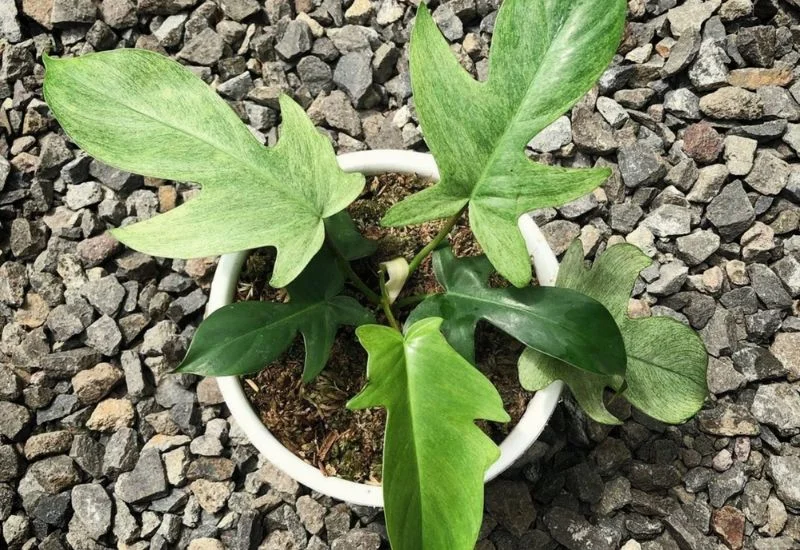
Generally, planting the Philodendron Florida Ghost involves the stem-cutting method, which is very easy. Here’s a step-by-step guide to successful propagation:
Choose a Healthy Stem: Choose a solid and elongated stem with a node(the point where the leaves are born from) and an aerial root. The node is also important as that is where new roots will develop.
Cut the Stem: A cutting should be made below a node using a clean, sharp knife or pruning shears, making the cutting 4-6 inches long.
Prepare for Rooting: Remove most leaves from the stem cutting, but keep some at the top. This reduces water evaporation and directs energy to the growth of the root system as the Plant establishes itself.
Water Propagation: Place the cutting in a glass of water so the node is immersed. This ensures the roots get a new water supply for development.
Soil Propagation: You can place the cutting directly in a pot having a proper potting mix with good drainage. Water the top layer only and ensure that the pot has good drainage; put the pot in an area that receives partial sunlight.
Wait for Root Development: Roots should start showing within 2-4 weeks if not produced, then cutting can be transplanted in a pot having a regular soil mixture.
Repotting
The Philodendron Florida Ghost should be repotted every 1-2 years, especially when it becomes too crowded or outgrows its pot. Here’s how to do it:
Choose the Right Time: It is recommended to report during the growing season, usually in spring or early summer, when the plant is most active.
Select a New Pot: Select a pot that is more significant than the existing one by 1-2 inches in diameter. This new pot must have drainage holes on the base for proper drainage to avoid over-watering that causes root rotting.
Prepare the Potting Mix: It is best to use the suiting and well-draining potting mix as far as possible; it is rich in organic content. As for the soil, it is better to use a 1:1:1 mixture of peat, perlite, and orchid bark for the Philodendron Florida Ghost.
Remove the Plant from its Current Pot: To prune a plant, you should carefully remove it without harming the roots. If the Plant is root-bound, gently prune the roots with your fingers.
Transfer the Plant: Shift the plant into the new pot and add fresh compost around it. Press the soil down lightly to eliminate air spaces, but do not pack the soil.
Water and Care: After the repotting process, it is recommended that the Plant be watered well and placed in an environment where it gets bright and indirect light but not direct sunlight. Water the plant periodically to the extent possible for the coming weeks to enable it to adapt well to its new surroundings.
Care
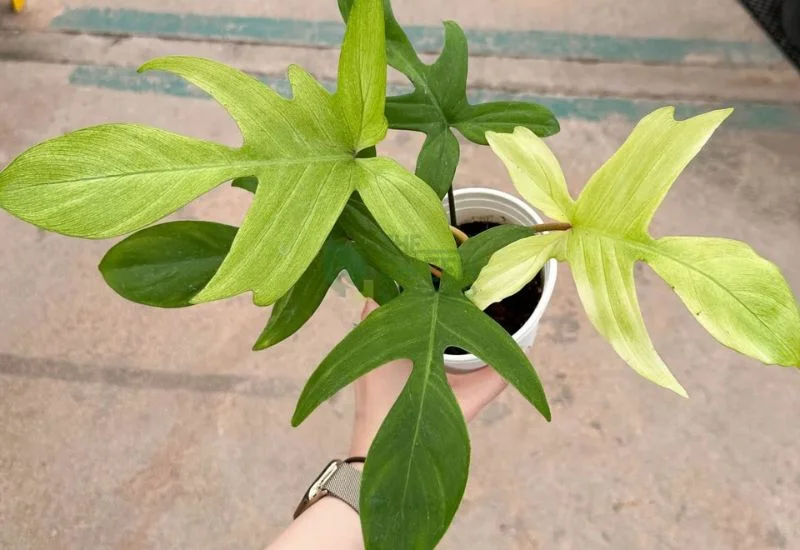
The care for each indoor Plant is specific and necessary. Indoor precious species remain healthy and growing if the proper care guidelines and steps are followed.
Here are some critical steps and considerations to pay for a philodendron Florida ghost;
Pruning
Trimming the shape of the Philodendron Florida Ghost is vital for its development. Pruning the plant is essential as this will help eliminate any withered, torn, or yellow leaves.. It also assists in controlling the plant’s growth and ensures that you grow long and thin plants instead of short and bushy plants. Pruning also saves energy for the production of new leaves and roots.
Next, remove any undesired growths with a well-sharpened pair of pruning scissors to enhance axillary branching. Where needed, make the cuts just above those points on the stem. Pruning is preferably done early in the growing season, generally in spring and summer, when plant is in the active gowth.
Soil
It grows in rich, well-draining soil. Fresh, loamy soil for aroids or tropical plants would be perfect, but if you cannot get it, a good seedling mix will be better. Soil with peat moss, perlite, and orchid bark is ideal for growing.
Such work permits the roots to breathe but does not allow root rot to develop.
Pot
The type of pot you decide to use has the potential to affect the well-being of your Philodendron Florida Ghost. A pot with drainage holes is crucial because it avoids water formation at the bottom.
Pots made from terracotta pot material are better as they provide better air circulation, though plastic pots are also safe if they aren’t sealed.
Water
This Plant should be moderately watered. The Plant requires constantly moist soil that is not waterlogged, with a pH between 6 and 8.
Irrespective of the growing medium used, water the Plant when the surface of 1-2 inches of the growing medium feels dry to the touch. Plants are actively growing during the spring and summer months, it may be necessary to water in growing season more frequently than during their dormant seasons.
Light
More specifically, do not place Philodendron Florida Ghost in direct sunlight as it enjoys indirect bright light to keep the colourful form of the leaves. Excess sun exposure leads to scorching of the leaves, while minimal exposure hampers the growth of the Plant. So, a maintain a proper light.
Fertilizer
Fertilize the Philodendron Florida Ghost during the growing season to maintain its healthy green leaves and sturdiness. A balanced and soluble fertilizer in water with an NPK ratio of 20:20:20 or an equivalent is recommended.
By spring and summer, apply fertilizer every 4-6 weeks, but ensure that you use a diluted solution since direct fertilizer may damage the Plant. During the fall and winter, it is advisable to cut down or even stop applying fertilizer because growth during these periods is relatively slow.
Placement
The Philodendron Florida Ghost is comfortable in a warm and humid climate, allowing it to grow indoors in a bright room. Do not place the Plant near windows or doors or flow cool or hot air from the air conditioners or heaters that cause stress to the Plant. This is why creating a bathroom or kitchen with sufficient natural light and high humidity is desirable.
If the indoor air is dry, it is recommended to put a humidity tray or even a humidifier with the air humidity level set to 60-80%.
Common Problems
Here are some common problems related to florida ghost are discussed with their respective solution;
Pests
Philodendron Florida ghost and other indoor plants are primarily sensitive to common pests like aphids, mites, and mealybugs. These pests may damage the plant leaves, stunted growth, or cause structural damage.
So, check for any manifest of these pests and use the spray if noted.
Fungal Diseases
A fungal disease can also be fatal to this species of Philodendron. The main reason behind the fungal infection may be water logging.
These include leaf spots, root rots and powdery mildew.
Brown Tips
Brown tips are another problem with indoor plants, such as the Philodendron Florida Ghost. The leaves of the plant typically have brown tips due to environmental stress.
This can be due to a lack of water, low humidity, or overly sunny conditions, like exposure to direct sunlight. To cure brown tips, first, check the watering schedule and make sure the soil is always damp but not water-logged.
Among these, the humidity should be raised by spraying the plant, using a humidity tray, or placing a humidifier. Also, inspect the light conditions and replace the Plant with a more illuminated area with filtered light.
Curling Leaves
The curling of leaves may be due to a shortage or excess of water, low humidity, or improper light. When a plant’s leaves roll up, it is a sign that the plant needs water or lacks humidity.
It is also essential to ensure the soil is moist, ideally in all conditions, and increase the humidity around the plant if necessary.
Yellow Leaves
Yellow leaves may occur due to poor lighting. If you notice that the leaves of the Plant are going to yellow, check the placement of your plant. Put it in a proper indirect light. The light should not be too dim that the plant cannot continue its essential reactions efficiently, nor too severe to burn the leaves of the Plant.
Varieties & Similar Plants
Several other plants share similarities with the Florida Ghost in terms of appearance, care requirements, and growth habits:
Philodendron Pedatum: Normally called the “Oak Leaf Philodendron” because of the deeply subdivided leaves, it is related to the Philodendron Florida Ghost. They have similar forms, but their leaves are usually green and not blotchy.
Philodendron White Knight: The most famous Philodendron variety is the White Knight, for the white parts of the Plant are ‘painted’ on the significantly dark green leaves. It has an identity of climbing habits and its care as the Philodendron Florida Ghost.
Philodendron Birkin: The pattern of the Philodendron Birkin is also pretty; the leaves of this Plant are essentially white pinstripe deep green. It also distributes its leaves differently than the Florida Ghost, but it is similar in how it grows and is best in bright, indirect lighting.
Monstera Deliciosa: Although the Plant is not a Philodendron, the Monstera Deliciosa is often compared to the Philodendron Florida Ghost because of its large holey leaves and ability to climb. Giving the Monstera a typical look, its leaves grow small holes (fenestrations) as the plant ages.
Anthurium Clarinervium: Similar to the Philodendron Florida Ghost, the Anthurium Clarinervium has a tropical aura with its heart-shaped leaves painted with white veins. Although the care needs of both plants differ, they prefer the same environment, so it is best to group them in a collection.
